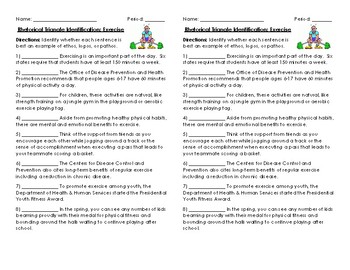Rhetorical Triangle Ethos Pathos Logos
These three Greek terms make reference to the primary concepts from which messagesin any communication channelare created. Logos can also be thought of as the text of the argument as well as how well a writer has argued hisher point.

Pin By Lauren Kirwan On Writing Workshop Rhetorical Analysis Rhetorical Triangle Rhetoric
Ethos Pathos and Logos are modes of persuasion used to convince audiences.

Rhetorical triangle ethos pathos logos. Rhetorical Triangle By understanding Aristotles three elements of persuasive speechthe ancient Greek words ethos pathos and logosstudents will be able to analyze the effectiveness of rhetorical strategies and elements in commercials and speeches. Ethos pathos and logos. Studies in Logology Boston.
Another type of appeal is pathos which attracts the readers emotions and feelings into the work. Pathos is about evoking an emotional response in viewers. This lesson could be used in grades 5-12.
A combined clothbound edition of Perspectives. Logos is built with enough evidence data statistics and reliable information. Download Ebook Ethos Pathos Logos The Rhetorical Triangle writing classes focusing on how such technology encourages writing and enables students to grasp basic composition skills in classroom settings.
THE RHETORICAL TRIANGLE is the art of persuasion whether you are trying to persuade someone to THINK something or DO something. The Rhetoric of Religion. Learn vocabulary terms and more with flashcards games and other study tools.
Ethos can also be thought of. Ethos appeals to the writers character. The Rhetorical Triangle httpwwwpublicasuedujvanasurhet-trianglehtm LOGOS idea message PATHOS force emotion ETHOS form manner Every communication is essentially a trilateral relationship.
Appealing to emotion by connecting with your audience through their values and interests Audience. Ethos is employed to convince by offering credibility. Logos ethos and pathos.
Each point of the triangle bears. Aristotles rhetorical triangle describes three diverse appeals. They are also referred to as the three artistic proofs Aristotle coined the terms and are all represented by Greek words.
When Malcolm began working with Muhammad he quickly gained recognition. Each point of the triangle influences the others and all are influenced by the context of the communication. Building trust by establishing your credibility and authority Writer.
Appealing to your audiences intelligence with well-constructed and clearly argued ideas Context. Rhetorical triangle ETHOS PATHOS LOGOS. To be persuasive the speaker must take the audience into consideration and appeal to them in ways that will convince them.
Considered together these appeals form what later rhetoricians have called the rhetorical triangle. Ethos Logos and Pathos. Many writers who use pathos.
Ethos pathos and logos. Ethos pathos and logos are techniques of persuasion that form the rhetorical triangle. The Greek philosopher Aristotle 384 BC322 BC described three appeals that can be used to persuade an audience.
Ethos or the ethical appeal means to convince an audience of the authors credibility or character. These three elements are shown in figure 1 below. University of California Press 1970.
The rhetorical triangle is a common reference to the three rhetorical appeals identified by Aristotle. Logos appeals to reason. Logos is based on facts and reasons explaining logical arguments that rely on information and evidence.
Books Books Perspectives by Incongruity ed. Indiana University Press 1964. The rhetorical triangle is typically represented by an equilateral triangle suggesting that logos ethos and pathos should be balanced within a text.
However which aspect s of the rhetorical. Ethos pathos and logos form what is called the rhetorical triangle A combo of all 3 appeals is most likely to persuade the audience. You can think of a speech as a rhetorical triangle such as the one below.
Malcolm X establishes ethos in his autobiography by being partners with Elijah Muhammad by founding the Nation of Islams first newspaper and by traveling as an emissary to meet world leaders. Logos is appealing to logic by use of verifiable data. Logos pathos and ethos.
Start studying Rhetorical Triangle - Ethos Logos Pathos. Appeals to that audience in three different areas. Rhetorical analysis essay using ethos pathos and logos Sine the founding of the United States one of the core beliefs most Americans hold is the idea of the importance of work ethic As you may have observed Oprahs speech is loaded with ethos pathos and rhetorical analysis essay using ethos pathos and logos logosLets say rhetorical analysis essay using ethos pathos and logos.
Stanley Edgar Hyman with the assistance of Barbara Karmiller Midland paperback Bloomington.
Logos Definition Literature Example
Logos is when we use cold arguments like data statistics or common sense to convince people of something rather than trying to appeal to an audiences emotions. Logos is appeal to reason or logic.

Rhetorical Devices Logos Ethos Pathos And Kairos
He argues on behalf of Tom Robinson who he knows is innocent but the world is ready to condemn him as guilty for raping a.

Logos definition literature example. If we think objectively logos should be the strongest type of argument. In To Kill a Mocking Bird Lee uses logos through her character of Atticus Finch. An appeal to logic.
Also called the logical appeal logos examples in advertisment include the citation of statistics facts data charts and graphs. Usually evident as facts numbers or statistics. One example of logos you might find would be a newspaper editorial listing examples of the success of child literacy programs in arguing for their further implementation.
They are means of persuading others to believe a particular point of view. This is an example of logos. Well logos is one of three main methods of argumentation put forth by ancient Greek philosopher Aristotle.
Thus it can also mean argument and reason. Socrates is a man. One of the three Aristotelian appeals.
Examples of Logos To Kill a Mocking Bird by Harper Lee. He George Orwell mostly uses logos in the speeches that the loyal pig of Napoleon Squealer gives to all the animals on the farm. They are often used in speech writing and.
But of course you can also go with good ol fashioned logic. Pathos has the power to evoke many emotions in a reader or audience of a literary work. Many of Shakespeares sonnets take the form of impassioned pleas on the part of a narrator who uses logos to justify their love and seek reciprocation from the object of their desire.
Logos means to persuade by the use of reasoning. Sometimes people argue their case by appealing to ones emotions. When you use logos you are persuading with logic based on evidence.
Common Examples of Emotions Evoked by Pathos. In Animal Farm George Orwell uses logos in almost every speech that any of the animals give. Define logos in literature.
Heres an example of logos in action from our man Aristotle himself. Logos is the persuasive technique that aims to convince an audience by using logic and reason. It connotes the content rather than the style which would be lexis and often implies logical reasoning.
Here are some common examples of emotions evoked by pathos in literature. Logos is one of the three appeals of persuasive writing and speaking. In summary logos is.
The definition of logos in literature is a rhetorical device that appeals to logic and reason. Aristotle statue as examples of logos. All men are mortal.
The word logic is derived from logos. Logos uses facts and evidence to convince a reader or listener of the strength of your argument. Logos is different from pathos which is an appeal to the emotions and ethos which relies on the ethics or credibility of the person making the argument.
Other times people appeal to others ethics or morals. Logos has many meanings notes George A. It is anything that is said but that can be a word a sentence part of a speech or of a written work or a whole speech.
Examples of Pathos in Advertisement. He believed logos outranked the other two in importance due to the fact that any argument no matter where its made needs logic to work. Logos is the Greek word for word however the true definition goes beyond that and can be most closely described as the word or that by which the inward thought is expressed and the inward thought itself 1.
Examples of Ethos Logos and Pathos Aristotles modes for persuasion - otherwise known as rhetorical appeals - are known by the names of ethos pathos and logos.
